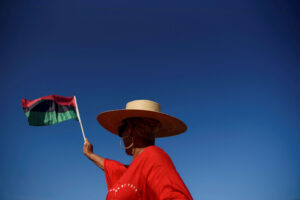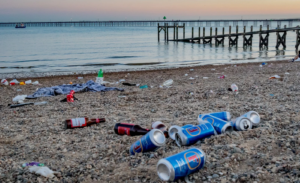Goods from all over, including Turkish nuts in Egyptian jars, found in ship that sank off Ma’agan Michael in northern Israel 1,400 years ago belie ‘dark Age’ after the Muslim conquest of the Levant
In 2005, two amateur divers from Ma’agan Michael, a kibbutz on Israel’s northern coast, spotted old timber, pottery fragments and ballast stones at the bottom of the Mediterranean Sea. They did alert the authorities, but the sea quickly covered the remains with sand again, and the shipwreck was lost.
Happily, it was rediscovered a decade later by researchers from the University of Haifa, who realized that it’s a 1,400-year-old wreck of a merchantman from the early Islamic period. Labeled the “Ma’agan Michael B ship,” this large, well-preserved vessel is one of the major discoveries in maritime archaeology in years, and may change the perception of a period thought of as a dark age, marked only by war and international isolation.
“We have very few shipwrecks from this period and they are mostly smaller, coastal vessels,” says Deborah Cvikel, a professor of nautical archaeology at the University of Haifa who leads the underwater excavation. “Here we have a large, nicely built merchantman that could brave the open seas, and that’s one of the things that make it unique.”

The Ma’agan Michael B ship, or MMB for short, should not be confused with another ancient vessel that was raised from the sea-bottom in front of this same kibbutz in the 1980s. This more famous Ma’agan Michael ship (without the “B”) is smaller and much older, dating to the fifth century B.C.E., the Persian period.
The MMB, instead, dates to between 648 and 740 C.E., the century that immediately followed the Muslim conquest of the Levant and the establishment of the Islamic Caliphate. Evidence collected from the wreck over seven years of underwater excavations indicate that the ship transported goods between Christian- and Muslim-controlled territories, and was manned by a multicultural crew, Cvikel says.
This challenges the traditional view of the early Islamic period as an era of little contact between Mediterranean regions, with activity in the sea consisting mainly of naval conflict between the Muslims and the Byzantine Empire, says Sierra Harding, a PhD candidate who studies animal bones found in marine digs.
By the sixth century, the Western Roman Empire had long fallen. Meanwhile, even before the Muslim expansion into the Middle East and North Africa, these regions were being ravaged by a plague pandemic, climate change and a brutal war between the Byzantine and Persian empires.
Couple that with the paucity of written records and of major shipwrecks from the period, and researchers have generally assumed that once the Muslims prevailed in the 7th century, overseas maritime trade pretty much ground to a halt, Harding says.
Yet the MMB ship belies that, as the 25-meter-long vessel carried at least 200 amphorae laden with produce including walnuts, olives, dates, figs and garum (an ancient Roman fermented fish sauce), Cvikel and team reported in a 2020 study.
The cargo must have come from different areas: for example, the garum contained bones of fish from the Sea of Galilee, while the walnuts were probably native of colder climes, such as the mountainous areas of Turkey or Syria.
The ship also transported baskets of freshwater mollusks from the Nile and caged wild birds that migrate through the northern Sinai.
The clay amphorae used to store the produce are also a mixed bag, with stylistic and chemical analysis suggesting they came from different spots, including Egypt, southern Palestine and Cyprus.
“Interestingly, we found walnuts in an Egyptian amphora, but you don’t have walnuts in Egypt, so what traveled where?” Cvikel wonders. “Did the walnuts come from Turkey to Egypt and then were loaded into this amphora or did the amphora travel from Egypt to Turkey? It’s one of the things we are still trying to figure out.”


Another interesting aspect of the cargo is that the MMB was carrying a shipment of glass fragments: broken off pieces of artifacts, jewelry, but also raw blobs of glass and other waste products of this industry. Aside from two bottles, which were found in a different part of the ship and may have been used by the crew, the archaeologists were unable to reconstruct any artifacts from these hundreds of shards.
This suggests that the glass cargo was already in pieces when it boarded the ship and was probably destined for recycling at a workshop in the region, Cvikel and colleagues concluded in a 2021 study.
Chemically, the fragments came from Egypt and Palestine, and we know that during the Roman and Byzantine periods these were both important glass-making areas. The discovery of this regional trade in scrap glass shows that the industry was still doing brisk business in the early Islamic period, Cvikel says.
Telltale rats
We don’t really know where the MMB ship came from or where it was going when it sank. Conservatively, Cvikel says it may have been sailing a triangular route between Egypt, Cyprus and somewhere in the Levant.
However, the ship may have sailed even farther, Harding suggests. Buried in the bowels of the vessel, divers found the remains of six rats, and at least two of them belonged to variants typical of central Mediterranean islands, such as Corsica or Sardinia, she says. This could indicate that the ship sailed to those lands too. Alternatively the ship could have picked up this particular infestation in any port, from other vessels that had gone to the central Mediterranean.

“In both cases, we see that during this time we have plague and we have war and yet we still have shipping and cargo connecting the central Mediterranean and the southern Levant, and that starts to open up our idea about the level of communication that was happening,” Harding says. (On a side note, the rat corpses were found deeply embedded in the MMB’s structure, suggesting they may have already been dead when the vessel sank, thus preserving the veracity of the old adage about these rodents leaving a sinking ship).
The ship itself was a costly project. It was constructed using shipbuilding techniques that were advanced for the time, and made using fir and walnut wood, a strange choice because the latter is particularly expensive, Cvikel says.
“Was she built in a place where those trees grow together or was the wood imported from different places?” she says. “We don’t know this yet, but certainly a lot of investment was put into this ship.”
A clue as to where the MMB was built may come from the study of a layer of resin that was laid to protect the timber from rot. Similarly to insects trapped in amber (tree resin that fossilized) millions of years ago, this sticky layer attracted and trapped bugs while it was still wet. Experts are studying the insects to try to figure out where their natural environment was, and by extension, where the ship was built.
The fact that foodstuffs, rat skeletons, bugs embedded in resin, as well as the bones of sheep and goats that were eaten by the crew have all been found aboard gives you an idea of how perfectly preserved the vessel is, possibly because it was covered by sand very quickly after it sank.
As for the sinking itself, it probably occurred in late fall or early winter, based on the seasonality of the fresh fruits found aboard, the archaeologists hypothesize.

The ship was probably not heading for Ma’agan Michael but may have been aiming for the ancient port of Tel Dor, just 5 nautical miles (10 kilometers) to the north. Because both locations have a chain of four small islands in front of them, the MMB crew may have confused the two spots, possibly because of bad weather, and run aground in the shallow waters in front of Ma’agan Michael, Cvikel says.
No bodies have been found in the wreck, suggesting that the sailors aboard may have safely reached the shore, she says.
Allah protect us
This however does not mean that we can say nothing about the crew, which the archaeologists estimate would have numbered around eight people. Clues to their identity have been left in the dozens of inscriptions painted or carved both on the amphorae of the cargo and the timbers of the ship itself. These writings include Greek and Arabic letters, as well as Christian crosses and Muslim invocations, such as bismillah – “in the name of God.”

In some cases, crosses and Greek letters on amphorae mark them as containing produce from various monasteries, which were very important in the economy of the period; and that could apply here too. But the use of Christian symbols and Arabic invocations to Allah carved into the ship’s wood were likely a way to bless the vessel’s perilous journeys across the sea and protect the crew, the archaeologists suggest.
The mix of alphabets and religious symbols points not only to the somewhat surprising fact that several people aboard must have had some level of literacy but also to the likelihood that the ship was manned by a multicultural crew of Christians and Muslims, Harding says.
“One of the biggest takeaways from this shipwreck is that, in the past as in the present, normal people are more connected and united in working together than the history books would have you believe, based on geopolitical narratives of wars and battles,” she tells Haaretz. “These are just regular people trying to make a living, selling things that they bought along the way.”
The archaeologists plan to continue investigating the shipwreck and believe it will yield many more discoveries about daily life in the early Islamic period. However, at this time, there are no plans to raise the ship from the sea because of its large size and lack of proper facilities to host the hull, Cvikel says.
Raising the ship would be “an immense project, that would probably take a lifetime.” So, for the moment, the secrets of this unique shipwreck will remain accessible only to maritime archaeologists, and the fish.




